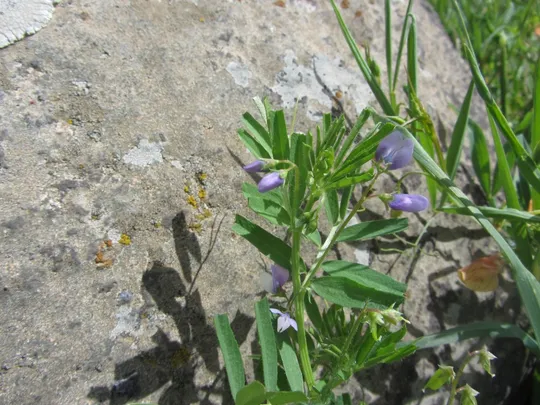Hula Vetch
Vicia hulensis




Vicia hulensis is limited in its distribution to the eastern Upper Galilee, the Lower Galilee and the Golan. It was first collected on the slopes of the basalt hills descending from the Golan to the Hula Valley, above Gonen, and was then described as a new species (Plitmann, 1965). In the 1980s, it was collected for the first time from two sites at the center of the Golan Heights: Mount Hozek and En Ǧwiza. Since then it has been found at three other sites: En Za'arta (in Yardinon Stream, above Shamir), the Hushnia Iris Reserve and Ǧalbina. In the Upper Galilee, the sites are concentrated on heavy basalt soil on the Dalton and Alma Heights, in a limited area of 3 x 6 km. The species was discovered In the Lower Galilee during the rare species survey in 1993. It grows on heavy soil of basalt origin, in Na’ura, Wadi En Dor, Sde Ilan, and Bet Keshet and at a single site near the Arbel.
Heavy basalt soil fields, occasionally flooded in winter. Vicia hulensis can also be found in slightly rocky areas, on tuff, and on scoria slopes.
For the genus, see Vicia basaltica.
V. hulensis belongs to the Vicia group of small and delicate annuals that have small numbers of flowers in its inflorescence (2-8), on a common pedicel. V. hulensis is systematically close to V.pubescens that grows at the edge of moist woodland, and to V. basaltica that grows in a habitat very similar to that of V. hulensis. V. hulensis differs from commonest species of the group in Israel, V. palaestina in 1) the head of leaflet is truncated and very rarely dentate, unlike the narrow, pointed leaflet, (or with a single protuberance) found in V. palaestina. 2) The stipule is dissected-dentate, unlike the simple stipule found in V. palaestina, 3) the number of flowers and their size: 1-3 7mm flowers, compared to 3-8 smaller flowers in V. palaestina, 4) especially in the form of the short and wide pod wide compared with the narrow elongated pod, usually containing two seeds, that is found in V. palaestina. V. palaestina sometimes has stems 1 m or more long, that tend to climb and entwine on neighboring plants, while V. hulensisis is low and often shaped like a spread out cushion.
• Vicia hulensis is endangered because of the limited number of sites (estimated at 18) it is found in, which are located mostly in the Golan Heights and Lower Galilee, limited to a rare habitat of flooded volcanic soils.
• The total number of individuals sampled in the 1993-1994 survey is estimated at 5,000, a very low number.
• All the V. hulensis sites are easily accessible and potentially highly vulnerable – in the Golan Heights because of cattle grazing and in the Galilee because of agricultural activity.
• The only site included within a nature reserve is that on Bashanit Ridge.
A survey should be conducted in the Golan and on the slopes of the Hula Valley in habitats flooded in winter to find and identify Vicia hulensis populations. Two populations should be monitored: near Alone HaBashan and near Na’ura. A reserve for the species should be established near the Na’ura site.
Vicia hulensis is an endemic species, which has not been discovered so far, in adjacent Levant countries. According to its habitat, it could probably be found in the Bashan.
Vicia hulensis is an extremely rare annual legume endemic to Israel that grows in a few sites in the eastern Upper Galilee and the Golan. It is endangered due to the rarity of its habitat (particularly in the Upper Galilee) – heavy basaltic soil that is flooded in winter and the limited number of individuals on a global level and the small size of populations at each site. The sites are extremely sensitive to agricultural development.
Plitmann, U. 1965. Three new Legumes from Israel. Israel.J.of Botany. 14:90-96.
Plitmann, U. 1987. Vicia basaltica sp. nov. and its relationship to V. hulensis. Israel.J.of Botany. 36:25-30
Cohen, O. & A. Shmida. 1991. Botanical notes. Israel Land and Nature.(Vicia hulensis) 16/3:145.
Current Occupancy Map
| 1000 squre meter pixel | 5000 squre meter pixel | 10000 squre meter pixel | |
|---|---|---|---|
| number of observations | 0 | 0 | 0 |
| in total pixels | 0 | 0 | 0 |
| Family | Fabaceae |
| Classification | On the endangered species list |
| Ecosystem | Mediterranean |
| Chorotype | Endemic (Eastern Mediterranean) |
| Conservation Site | Bashanit Ridge Reserve |
| Rarity |
1
2
6
|
|---|---|
| Vulnerability |
0
2
4
|
| Attractiveness |
0
0
4
|
| Endemism |
0
4
4
|
| Red number |
1
4.2
10
|
| Peripherality | 0 |
| IUCN category | DD EW EX LC CR EN VU NT |
| Threat Definition according to the red book | Endangered |
 Based on:
Based on:






